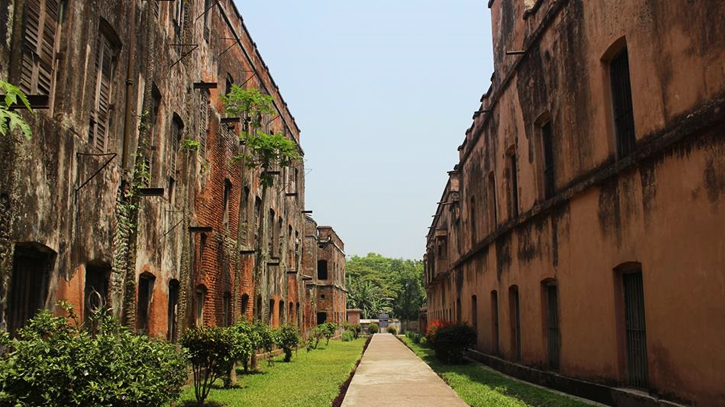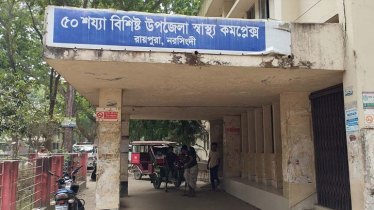
Known locally as Baliati Zamindarbari, this palace serves as a repository of history, encapsulating the rich legacy of the Baliati zamindars. Photo: Messenger
The Baliati Zamindar House stands as a testament to history, representing one of the few historical buildings in Manikganj, situated approximately eight kilometers east of the district town. Established in Saturia of Manikganj in 1790, the Baliati zamindar house is a significant heritage site with roots tracing back to Govind Roy Saha, a prosperous salt merchant and the forefather of the zamindars, who initiated the construction of the house.
Known locally as Baliati Zamindarbari, this palace serves as a repository of history, encapsulating the rich legacy of the Baliati zamindars spanning nearly a century. Their influence extends from the first half of the 19th century to the initial decades of the 20th century, contributing significantly to the antiquities of the district.
Constructed in the 19th century AD, the Baliati Zamindar House is a distinctive architectural marvel, reflecting the unique historical and cultural aspects of the region. Notably, the zamindar clan of Baliati originated from a humble Saha family, showcasing the diverse and fascinating narratives that are woven into the tapestry of this historical site.
The construction of the Baliati Zamindar House unfolded in successive stages, culminating in the completion of the building. Presently, the property is under the jurisdiction of the Public Works Department, which operates under the Ministry of Public Works. It serves a dual purpose, functioning both as the official museum and the official tourist center.
The notable zamindars associated with Baliati were Babu Kishori Lal Roy Chowdhury and Babu Hiralal Roy Chowdhury, who, along with their ancestor Govind Roy Saha, played pivotal roles in the establishment and evolution of the zamindari. The lineage of the zamindars spanned approximately a century, from the early 19th century to the early 20th century, making significant contributions to the socio-economic landscape of the region during their tenure as landlords for about 100 years. The Baliati Zamindar House, now a museum and tourist center, stands as a living legacy to this historical period and the cultural richness embedded in its architecture and artifacts.
The Baliati Zamindar House, locally known as Golabari, had a distinctive feature in its north-west part—an expansive granary of salt. This characteristic earned the house the name Golabari. The region around Golabari square witnessed the Baruni fair in those times, creating a vibrant cultural and festive atmosphere. Additionally, Rath Utsav, a chariot festival known as Basat Rath Mela, was organised on the west side of Palm pond, adding to the cultural richness of the area.
However, due to space constraints, the chariot fair is no longer held at the original location. Instead, the Rath Utsav is currently organised next to the Kali temple in Puran Bazar of Baliati village.
The historical Baliati Zamindar House has a significant moment in its history associated with the zamindars entering the house on the 1st day of Baisakh in the Bengali calendar year 1300. The estate, sprawling over 5.88 acres of land, boasts a prominent and picturesque location, featuring a large pond in front of the zamindar house.
The facade of the house is adorned with four grand palaces, each complemented by well-arranged Singhadwars, creating an impressive architectural ensemble stretching gracefully from west to east. The visual appeal of the structure is further enhanced by these intricately designed entrances. However, it is noted that the ghats (steps or platforms) of the pond have deteriorated over time.
The grandeur of the Baliati Zamindar House extends to its interior, comprising seven palatial buildings with a total of 200 rooms. This extensive estate not only serves as a testament to the historical significance of the zamindars but also stands as a captivating architectural and cultural landmark in the region.
The entrance to the Baliati Palace is adorned with a distinctive feature known as the "lion door," which consists of four stone lion statues positioned at the top of each entrance. This architectural detail adds a unique and regal touch to the palace, creating a visual spectacle known for its historical and aesthetic significance.
Zamindar Kishori Lal Roy Chowdhury, a notable figure in the region's history, made significant contributions to education. In 1884, he established Jagannath College in the capital city of Dhaka, naming it after his father. This educational institution has evolved over the years and is now known as Jagannath University. In 1887, Kishori Lal Roy Chowdhury also founded Kishori Lal Jubilee High School, named after himself, demonstrating his commitment to education.

Jagannath University continues to be a prominent educational institution in Dhaka, with several thousand students currently pursuing their studies there.
It is mentioned that Kishori Lal Roy Chowdhury passed away in 1925, leaving behind a significant impact on education and the community.
All the vassals (servants or subjects) of the zamindars have migrated to India. It is now vested in the Public Works Department under the Ministry of Public Works.
The decision of the Public Works Department to take responsibility for the historical Baliati Palace and transform it into a museum and tourist center reflects a proactive approach toward preserving cultural heritage and promoting tourism.
By converting the palace into a museum and tourist center, the government is able to generate income through visitor admissions and related activities.
The information about the operation schedule of the museum and tourist center at the Baliati Palace, being closed on Sundays and having half days on Mondays.
The expansive estate, established on 5.88 acres of land, encompasses a grand palace with 200 rooms distributed across seven buildings. The presence of a pond within the premises adds to the overall charm of the property. The historical significance of the pond is further highlighted by the mention of seven ghatlas, although the current count is six. The ghatlas, known for their beauty, likely served various purposes and may have been aesthetically designed.
Messenger/Sun Yath








